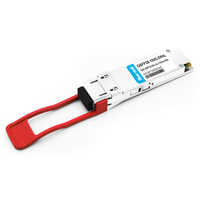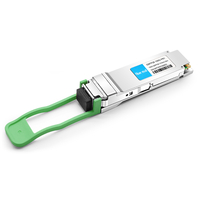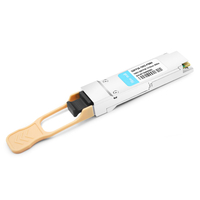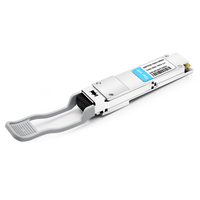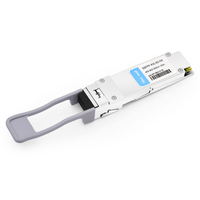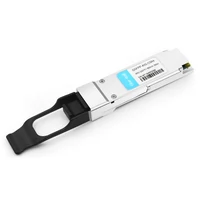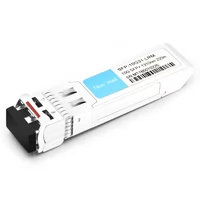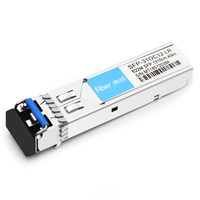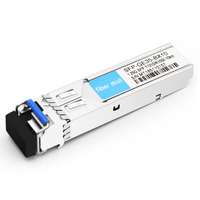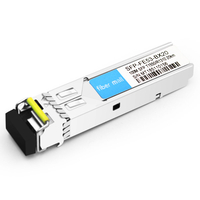To thrive in the present quick and digital world, one must identify proper hardware for networking infrastructures that guarantee effectiveness and dependability. These network systems rely on HPE transceivers for connection and optimization, enabling the smooth passage of information through different channels. This piece aims to explain HPE transceivers, including essential features, types, and specifications needed when making choices based on knowledge. It is only by comprehending the ins and outs of these devices that people can evaluate their networking requirements better, thus going for what suits them most, considering their surroundings.
Table of Contents
ToggleWhat is an HPE Transceiver and How Does It Work?
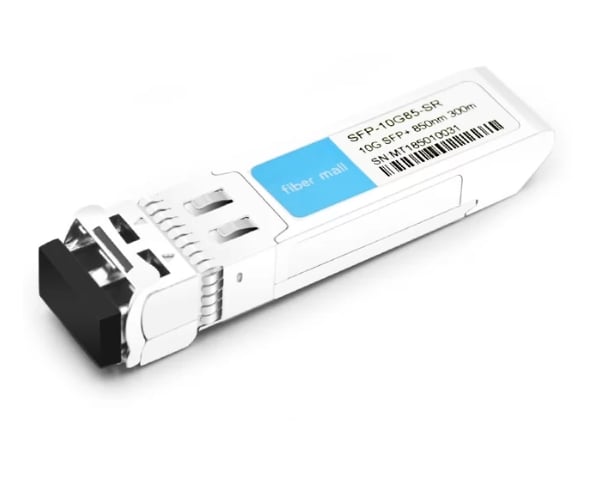
Understanding HPE Transceiver Modules
The HPE transceiver module is a small device that converts electrical signals to light signals and vice versa. These devices send data very quickly through fiber optic or copper cables in different networking applications like enterprise networks, data centers, and telecommunications systems. Each transceiver module has some features that include size, compatibility, wavelength, and speed of data transmission, among others, which determine how well it performs under particular network settings. This scalability feature allows organizations to change their connectivity easily as they grow, thus saving on costs.
How Do HPE SFP Transceivers Enhance Network Performance?
The network’s overall performance greatly increases through HPE SFP (Small Form-factor Pluggable) transceivers by making data transfer faster and ensuring it can work with different networking devices. These are smaller than many other fiber optic transceiver modules, so they take up less space in switches and routers and allow for more densely packed ports. This is achieved by supporting multiple data rates and distances to optimize each one as needed, customizing it to fit any given network requirement. Moreover, being hot-swappable means there will be hardly any downtime during upgrades or repairs, thus enhancing network reliability and continuity. In summary, HPE SFP transceivers are critical components used to streamline the flow of information while enhancing efficiency across an entire system.
Compatibility: Ensuring Your HPE Transceiver Matches Your Equipment
You must do several things to ensure compatibility between your HPE transceiver and the rest of your networking equipment. First, verify the form factor since these transceivers are designed for particular slots in switches or routers. You should also check whether it works with the firmware version on this device because using outdated firmware may limit its performance or features. Another important point is matching the supported data rate and distance on a transceiver to what your network requires so that there are no bottlenecks in performance. Finally, consult the documentation for this hardware or look at HPE’s compatibility matrix, which lists all models that can work together and provide the best integration and functionality.
How do you select a solution for HPE BladeSystem?
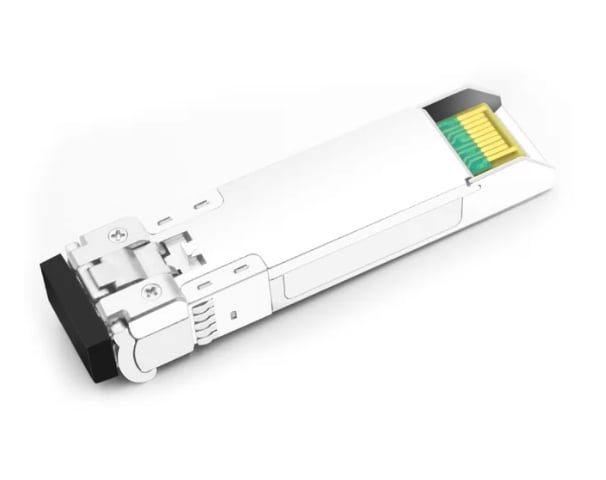
HPE BladeSystem C‑Class vs. Other Options
When picking out a solution for HPE BladeSystem, you must consider some unique functionalities and benefits of C-Class compared to other blade server alternatives. The HPE BladeSystem C-Class is designed for high-density environments and comes with integrated management capabilities provided through the HPE OneView software platform. This enables simplified provisioning, monitoring, and management, significantly reducing operational overheads. On top of this, the C-Class supports various workloads with flexible configuration options, thus allowing organizations to optimize performance and energy efficiency.
However, unlike these other systems, blades may not have such high levels of integration or scalability, making management more complicated than it should be sometimes. Moreover, HPE has an extensive range of networking storage solutions, which ensure seamless choice among them for the fully integrated infrastructure. Consequently therefore, while evaluating blade server choices, one cannot fail to notice that apart from having robust management features, the scalability ability of c class vis a vie other models and its compatibility with hpe’s ecosystem makes it more suitable for enterprises aiming at achieving long-term efficiency and adaptability in their operations.
Choosing the Right HPE Transceiver for BladeSystem C‑Class
It is important to align your choice with particular operational requirements and compatibility aspects when choosing an HPE transceiver for BladeSystem C-Class. Each of these is made to back up different networking protocols and distances. Here are some things that you should consider:
- Compatibility: Verify whether the transceiver is compatible with your specific HPE BladeSystem model and relevant Network Interface Cards (NICs), such as HPE QSFP, among others. This can normally be done by consulting the compatibility matrix or similar documents provided by HP.
- Performance Requirements: Evaluate what data rates and distances will be needed within your network. For example, use SFPs or SFP+s when connecting devices over short ranges. However, go for XFP-type optic modules if connecting devices across longer distances where high-throughput applications may also be involved.
- Network Environment: Consider existing network conditions and anticipate possible future changes, as they can change without any prior indication. If large bandwidth is required or low latency is necessary, advanced transceivers that support higher speeds and optical links will need to be considered.
Consider all these factors and select one that best suits your needs. This will ensure it functions optimally with HPE BladeSystem C-Class, improving overall network performance and reliability.
Benefits of Using HPE Compatible Transceivers
Utilizing compatible transceivers from HPE for enterprise networks is highly advantageous.
- This is cost-efficient: HPE-compatible transceivers often have a higher reliability and performance level than their OEM counterparts but are cheaper, resulting in significant savings on overall equipment costs.
- Compatibility and performance are improved: These transceivers are made to work seamlessly with HPE hardware, so they function optimally and have the least chance of interoperability problems that could affect network continuity across different devices.
- HPE has many types of transceivers, such as SFP28 or QSFP, which means there will always be something for everyone.: There is a large selection of HPE-compatible transceiver modules supporting different protocols over varying distances, thus allowing customization of solutions while ensuring quality service delivery according to specific network needs.
- Flexibility is increased: Using compatible transceivers allows organizations to easily scale their network infrastructure when necessary without being limited by proprietary hardware choices.
What companies can get from these features are systems that can handle any requirements at an affordable price.
Which HPE Networking Transceiver Options Are Available?
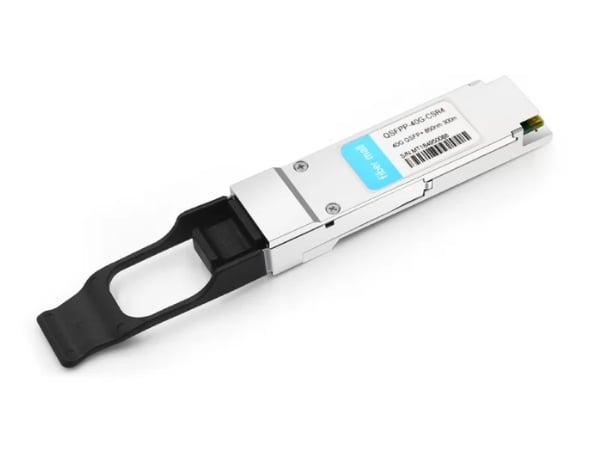
Popular HPE SFP Transceivers: 1G and 10G Options
HPE has a variety of SFP (Small Form-factor Pluggable) transceivers that can meet 1G and 10G network needs, thereby ensuring robust enterprise networking solutions flexibly.
- HPE 1G SFP Transceivers: The H3C SFP 1G LC LX is an example of HPE’s SFP 1G transceiver, which has a working wavelength of 1310nm and covers distances of up to 10 kilometers in single-mode fiber. These transceivers are perfect for low-latency applications and work well with different models of HPE networking equipment so that they can be integrated seamlessly into the system without affecting its performance.
- HPE 10G SFP+ Transceivers: For faster connections, there are those designed for higher bandwidths like J9150D, among other types under this category provided by HPE, which supports up to 10 Gigabit Ethernet application needs; it can transmit data over multimode fibers within a range not exceeding 300 meters or through single-mode fibers that span across distances no greater than ten kilometers. Its reliability and ability to offer wider channels have made many people prefer using it in data centers where high-performance networks are required.
- Compatibility and Standards: Both the one gigabit per second (1Gbps) and ten gigabits per second (10 Gbps) small form factor pluggable follow recognized standards; hence, they can interoperate not just with HPE devices but also with those from other manufacturers who adhere to such rules. This means organizations have more options when scaling up their networks since these items allow them to upgrade easily whenever necessary without experiencing compatibility issues with components manufactured by different vendors.
In summary, these various types of transceivers offered by Hewlett Packard Enterprise enable businesses to optimize their performance levels according to specific requirements during deployment stages while still considering the cost implications.
Optical Transceivers: SMF and MMF Varieties
Optical transceivers are primarily divided into two types based on the fiber used: single-mode fiber (SMF) and multi-mode fiber (MMF).
- Single-Mode Fiber (SMF): Designed for long-distance communication, SMF transceivers employ a single light beam that passes straight down the fiber. This arrangement reduces modal dispersion, thereby enabling data transmission over longer distances, typically 80 kilometers or even more, depending on the specifications of the transceiver and its application. It is most appropriate for use in wide-area networks (WANs) and telecommunications, where bandwidth requirements exceed what multimode fibers offer.
- Multi-Mode Fiber (MMF): In contrast, MMFs use several light modes, thus making them cheaper over short distances – usually not more than 300 meters. Data centers commonly utilize these cables since they need high bandwidths within limited proximities while often employing HPE QSFP transceivers. However, multi-mode fibers suffer from modal dispersion, which limits their use when considering the integrity of information being transferred at higher ranges.
Single-mode and multi-mode optical transceivers are essential components of any contemporary network infrastructure designed to meet different connectivity needs regarding distance or bandwidth requirements. Therefore, businesses can improve their network performance by selecting suitable transceiver types, such as HPE SFP28 compatible ones, for reliable data transmission across various distances.
Exploring HPE QSFP28 Transceivers for High-Speed Needs
HPE transceivers are designed to deliver high-speed data transmission in contemporary networking applications with a target data rate of 100 Gbps. They employ a four-channel design, each channel supporting 25 Gbps, making them perfect for cloud computing and big data analytics, among other data-intensive environments. HPE QSFP28 modules can seamlessly integrate with existing HPE networking equipment, ensuring compatibility and operational efficiency.
Moreover, HPE offers different types of this module that cater to various distances and network infrastructures, such as short-range, long-range, or active optical cable (AOC). These devices provide flexibility when it comes to deployment and enable enterprises to lower their overall bandwidth costs while significantly improving network performance levels. In other words, by using these transceivers, businesses can benefit from fast connection speeds for mission-critical applications, thus enabling organizations to stay competitive within an increasingly information-based world.
What Are the Key Features and Benefits of HPE Aruba Transceivers?
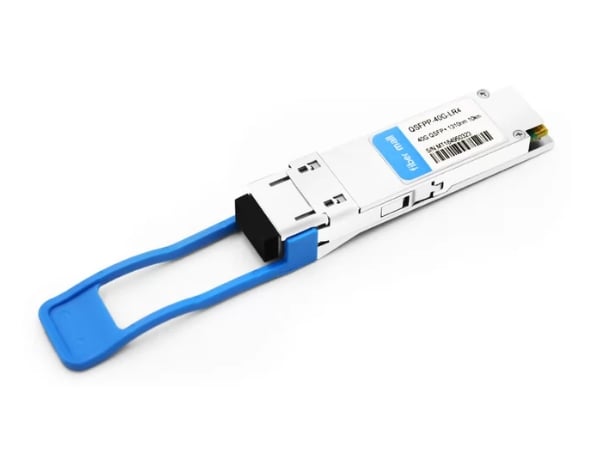
Integrating HPE Aruba Transceivers in Your Network
Integrating HPE Aruba transceivers into your network is a direct process that involves careful selection, which depends on network requirements and compatibility. They support many types of connectivity options, such as SFP, SFP+, and QSFP variants, which cater to different speeds and distances (up to 400 Gbps). Verifying with existing HPE Aruba switches and routers is essential to working smoothly together.
Generally, deployment includes putting the transceiver into suitable ports on networking devices, including compatible HPE models, and then configuring network settings so that they can recognize new hardware. Such steps could be simplified by HPE’s intuitive Software-defined Networking (SDN) solutions, which enable automatic detection and configuration of connected transceivers. Moreover, monitoring tools like Aruba Central make it easy to track the performance of a specific transceiver at any given time alongside the overall health of networks, thus ensuring everything is functioning optimally throughout an infrastructure. Organizations can improve their networking capabilities while creating a more resilient and agile network environment using HPE Aruba Transceivers, among other compatible products from this company.
Advantages of HPE Aruba’s Advanced Connectivity Solutions
HPE Aruba’s advanced connectivity solutions differ from other systems in several ways. First, they offer more flexibility than any other networks by allowing multi-gigabit speeds and supporting several form factors to match the needs of businesses. Second, being designed for large-scale use means they can expand easily as required by growing organizations; this capability is backed up by strong security measures like encryption built into them together with access controls that do not slow down performance but still safeguard sensitive information.
Additionally, HPE Aruba simplifies network management through AI-powered insights and analytics, allowing for proactive monitoring and quick identification of problems, thus reducing downtime while improving user experiences. Finally, it seamlessly integrates with existing infrastructure, making deployment easier and cutting costs, thereby presenting an attractive option for companies seeking to optimize their connection solutions without compromising operational effectiveness.
Case Studies: HPE Aruba Transceivers in Action
HPE Aruba transceivers have been used in many areas to see how they can improve network performance and efficiency. In one example, a top healthcare provider installed HPE Aruba transceivers across its network infrastructure to increase access points between different locations. Consequently, this allowed them to reach patient records faster, leading to better patient care and improving their operations.
Another case involved a large educational institution that implemented HPE Aruba transceiver to support digital learning expansion. These components are known for their speed and ability to scale; therefore, the college accommodated more students through online classes with seamless content sharing, among other platforms such as e-books, etc. This not only improved education quality but also made administrative processes easier.
Lastly, a substantial retail company used HPE Aruba Transceivers, thus optimizing their in-store connectivity for customer engagement applications. By doing so, they were able to get real-time inventory management and analysis, which significantly improved the shopping experience of its shoppers while increasing customer satisfaction levels. This led to higher sales volumes realized by the establishment, thus proving that, indeed, these advanced connectivity solutions offered by HP Enterprise’s subsidiary known as “Aruba” have transformative capabilities.
What Factors to Consider When Buying HPE SFP Transceivers?
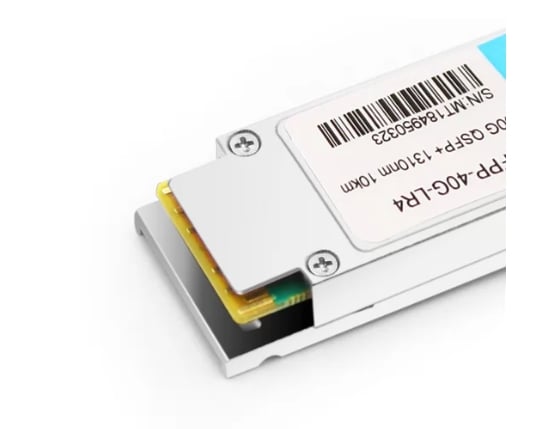
Assessing Your Network Requirements
To assess what is needed for HPE SFP transceivers regarding network requirements, several key considerations must be addressed to perform optimally and work well with other systems. First, the first thing one should do is figure out the exact speed and protocol required by their network because these devices come in different specifications like 1G,10G, and 40G, which serve various needs. Distance is also essential when it comes to this type of evaluation; depending on how far apart devices within your networks are situated will determine whether short-range (SR), long-range (LR) or extended-range (ER) transceivers should be used.
The other crucial point here has something to do with cable types employed throughout your infrastructure. You must ensure they match existing standards such as Single-Mode Fiber (SMF) or Multi-Mode Fiber (MMF) since it dramatically affects signal strength and width band. Also, think ahead about scalability needs – choose those modules that can easily be upgraded when necessary or compatible with future advanced technologies, thus safeguarding investments made in them eventually. Last but not least is security; don’t forget selecting these gadgets that support strong security measures could help secure against potential threats on the network, otherwise left defenseless. Evaluate all these factors well enough to enable informed decisions that align with organizational goals for performance-based network strategy.
Understanding Transceiver Pricing and Value
A few different factors set transceiver prices. Some of these are the technology type used, how far it can send data, and what company made it. This means that prices can vary quite a bit; for example, you might only have to pay between $10-$50 for primary SFP transceivers, but some high-performance models could cost over $500 if they support higher data rates or longer distances. It’s also worth noting that brand name recognition plays into this, too – manufacturers like HPE and Cisco often charge more because people know their stuff works well, and they offer excellent customer support.
When you’re thinking about buying an HPE SFP transceiver, think about long-term performance, compatibility with current systems, and different types offered, among other things. Sometimes cheaper options seem attractive at first glance, but they lack the features necessary for success or, even worse, come without any support, leading to failure. You should always invest in brands like HPE, which usually perform better over time and have better warranties, especially on SFP28 and other transceivers. Also, take note that technology changes rapidly, so make sure your choice allows easy future upgrades as this may save money significantly in addition to improving overall efficiency later on down the road; hence, upfront costs must be weighed against potential long-term benefits with the organization’s goals kept in mind while selecting transceivers to use.
Where to Buy HPE SFP Transceivers?
Several websites deserve special mention on the current search results page when it comes to buying HPE SFP transceivers. Among the most promising are those offering compatible HPE products.
- Hewlett Packard Enterprise (HPE) Official Website: The HPE store is a one-stop shop for all SFP transceivers, with detailed specifications and compatibility information provided. In addition to warranty assurance from the manufacturer, customers also get direct product support.
- CDW.com: CDW is a popular technology solutions provider that stocks various HPE SFP transceivers. In addition to competitive pricing, this site offers abundant information about each product, including user reviews; there’s also an option for bulk purchase—ideal when equipping several devices at once.
- Amazon.com: Amazon is an online marketplace, which means that It has numerous sellers who list HPE SFP Transceivers at different price points; however, buyers must be vigilant enough to ensure they review seller reputation and product authenticity before purchasing.
Each platform has its pros and cons, so it’s worth comparing prices between them, checking delivery terms, and checking the return policy before making any decisions on where to buy from.
Reference Sources
Frequently Asked Questions (FAQs)
Q: What do I consider when I want to know the suitable HPE transceiver for my networking needs?
A: While choosing an HPE transceiver, there are some essential factors that you ought to think about, such as whether it is compatible with your current enterprise account; what data rate it requires (e.g., 1G, 10G, or 40G); how far should the connection reach (e.g., up to 400m); what type of connectivity is needed (e.g., LC or RJ45); and where will it be used specifically – HPE BladeSystem C-Class environment or high-density data center among others.
Q: How can I tell if a device is compatible with my HPE BladeSystem C-Class?
A: To determine compatibility with your HPE BladeSystem C-Class, refer to the HPE Store US website or contact HPE support for general questions. Ensure that the transceiver module for HPE matches the specifications and requirements of your BladeSystem c-class model. They also offer high-performance Ethernet connectivity, which ensures optimal network performance.
Q: What’s different between 1G SFP, 10G SFP and 40G QSFP transceivers?
A: It supports up to 1 Gbps speeds, usually used in standard Ethernet connections. On the other hand, this one supports speeds of up to 10 Gbps, designed explicitly for high-performance network environments like those still growing. This type is meant to cater to bandwidth needs within high-density data centers where space may be limited while demand remains constant.
Q: Can I use an SFP RJ45 transceiver for long-range connectivity?
A: SFP RJ45 transceivers are generally best suited for short-range connections, usually not exceeding 100m over copper Ethernet cables. However, if you want longer-distance coverage, consider using optical transceivers, e.g., LR (Long Range) modules that can go up to 10km or even further, depending on the model.
Q: What is the difference between SX and LR transceivers?
A: The SFP SX transceiver is used for short-range connectivity over multimode fiber (MMF) and can cover a distance of approximately 550m. However, if you need to connect devices that are far apart, LR transceivers designed for long-range connections over single-mode fiber (SMF) should be used, as they can reach up to 10km or more. Your choice between SX and LR transceivers and offering types like SFP28 will depend on your specific distance requirements and fiber type.
Q: Do HPE MSA storage systems have specific transceivers?
A: Yes, HPE MSA storage systems have specific transceivers. These transceivers are compatible with HPE MSA and provide reliable, high-performance Ethernet connectivity for storage applications. Visit the HPE Store US to find appropriate models for your HPE MSA system.
Q: How do I ensure that my HPE networking equipment works at its best capacity and is compatible with other devices?
A: Always use transceivers explicitly designed for your HPE networking equipment to guarantee optimal performance and compatibility. Ensure compatibility with your current enterprise account; review what features/specs HPE provides; and ask general questions, if any, by contacting an expert from or related to Hewlett Packard Enterprise (HPE). You may also qualify for additional support and resources by engaging them or their subsidiaries/affiliates, especially concerning this brand’s compatible products.
Q: Where can I purchase HPE transceivers and receive guidance towards selecting the right one?
A: The easiest way is going onto the official website, i.e., The Hewlett Packard Enterprise Store US, then placing an order there; alternatively, authorized resellers stock these items too. For advice on choosing which type(s) would be suitable given your situation, please get in touch with the support team, who will provide the necessary information about such matters, or check out the different types under consideration section found somewhere within their site along with detailed descriptions specifying where they might apply in terms of usage scenarios but always remember some limitations could exist so don’t forget checking latest deals offered together with availability.
Q: How can I register a warranty or get help after buying a product like an HPE transceiver?
A: To register warranty coverage for your purchased products, like the transceiver, you need to browse through the store.us.hpe.com website and follow all the steps involved during the registration process, which may require providing a user ID and other relevant details. Nevertheless, if you already have an enterprise account, just log in using those credentials since it tends to streamline things.
Related Products:
-
 HPE Aruba JL743A Compatible 100G QSFP28 ER4 Lite 1310nm (LAN WDM) 40km with FEC, 30km without FEC LC SMF DDM Transceiver Module
$800.00
HPE Aruba JL743A Compatible 100G QSFP28 ER4 Lite 1310nm (LAN WDM) 40km with FEC, 30km without FEC LC SMF DDM Transceiver Module
$800.00
-
 HPE Aruba R9B63A Compatible 100G QSFP28 Single Lambda FR 1310nm 2km LC SMF with FEC DDM Optical Transceiver
$215.00
HPE Aruba R9B63A Compatible 100G QSFP28 Single Lambda FR 1310nm 2km LC SMF with FEC DDM Optical Transceiver
$215.00
-
 HPE X150 JH420A Compatible 100G QSFP28 PSM4 1310nm 500m MTP/MPO SMF DDM Transceiver Module
$180.00
HPE X150 JH420A Compatible 100G QSFP28 PSM4 1310nm 500m MTP/MPO SMF DDM Transceiver Module
$180.00
-
 HPE X150 JQ344A Compatible Dual Rate 40G/100G QSFP28 BIDI 850nm & 900nm 100m LC MMF DDM Optical Transceiver
$449.00
HPE X150 JQ344A Compatible Dual Rate 40G/100G QSFP28 BIDI 850nm & 900nm 100m LC MMF DDM Optical Transceiver
$449.00
-
 HPE H3C JH678A Compatible 40G QSFP+ SR Bi-Directional 850nm/900nm 100m/150m Duplex LC MMF Optic Module Receiver Only
$280.00
HPE H3C JH678A Compatible 40G QSFP+ SR Bi-Directional 850nm/900nm 100m/150m Duplex LC MMF Optic Module Receiver Only
$280.00
-
 HPE H3C JG709A Compatible 40G QSFP+ CSR4 850nm 400m MTP/MPO MMF DDM Transceiver Module
$60.00
HPE H3C JG709A Compatible 40G QSFP+ CSR4 850nm 400m MTP/MPO MMF DDM Transceiver Module
$60.00
-
 HPE BladeSystem 455889-B21 Compatible 10G SFP+ LRM 1310nm 220m LC MMF DDM Transceiver Module
$15.00
HPE BladeSystem 455889-B21 Compatible 10G SFP+ LRM 1310nm 220m LC MMF DDM Transceiver Module
$15.00
-
 HPE JF830A Compatible 622M OC12/STM-4 SFP LR 1310nm 40km LC SMF DDM Transceiver Module
$28.00
HPE JF830A Compatible 622M OC12/STM-4 SFP LR 1310nm 40km LC SMF DDM Transceiver Module
$28.00
-
 HPE H3C SFP-1G-BXD-10 Compatible 1000Base BX BIDI SFP TX1310nm/RX1550nm 10km LC SMF DDM Transceiver Module
$6.00
HPE H3C SFP-1G-BXD-10 Compatible 1000Base BX BIDI SFP TX1310nm/RX1550nm 10km LC SMF DDM Transceiver Module
$6.00
-
 HPE H3C JD101A Compatible 100Base BX BIDI SFP TX1550nm/RX1310nm 15km LC SMF DDM Transceiver Module
$9.00
HPE H3C JD101A Compatible 100Base BX BIDI SFP TX1550nm/RX1310nm 15km LC SMF DDM Transceiver Module
$9.00

